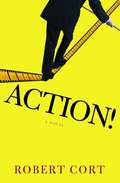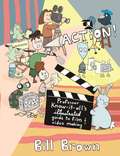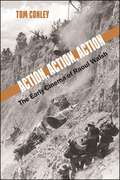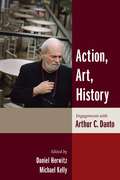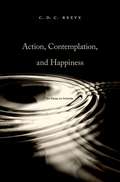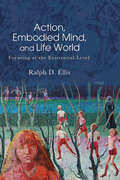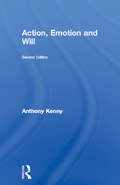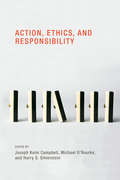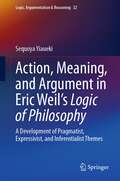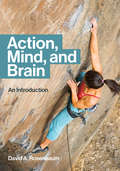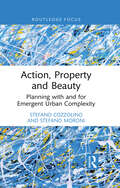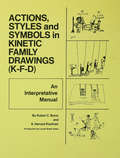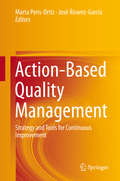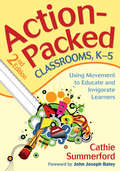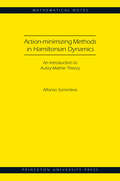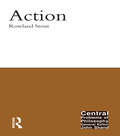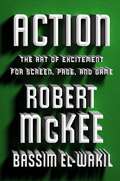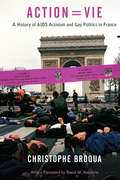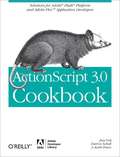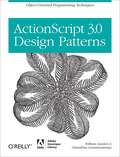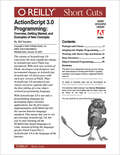- Table View
- List View
Action!: A Novel
by Robert CortWhat do you do when your oldest friend, Steve McQueen, pulls out his Smith & Wesson and blows your defenseless dining-room chair to smithereens? Or when your hottest client, sex goddess Romy Schneider, demands you leave your wife for her? Those are just a couple of the dilemmas faced by AJ Jastrow, the fictional protagonist of Action!, Robert Cort’s page-turning saga about a legendary Hollywood family. When we first meet AJ in 1948, a few weeks shy of his thirteenth birthday, he ranks as minor Hollywood royalty—Dad is the movie industry’s most prominent attorney, Mom is a retired actress whose uncle is Adolph Zukor, founder of Paramount. But this year will prove to be the end of the movie industry’s Golden Age and the beginning of exile for the Jastrow family.When AJ returns to Tinseltown after a decade’s absence, he realizes that fulfilling his father’s legacy of creating a movie empire will prove a life’s work. Along the way, AJ’s soldiers-in-arms include the Machiavellian producer Ray Stark, who teaches him how to win at Monopoly and studio politics; Wall Street genius Charlie Bluhdorn, who coaxes AJ to fly under the radar on a secret mission; AJ’s wife, Stephanie, who reminds him that a conscience isn’t a luxury; and his daughter and protégée, Jessica, who refuses to leave his side despite irresistible temptation.His enemies are formidable: studio president Paul Herzog, who seeks to destroy the son as he did the father; the wily agent Mike Ovitz, who intuits the weaknesses of any rival; AJ’s mother, Hollywood’s wealthiest woman, who cannot abide disloyalty; and AJ’s son, Ricky, an actor of uncommon ability, who holds a devastating grudge against his dad.By blending and transforming fact into fiction, by introducing real characters to fictional ones, Robert Cort gives the reader an inside account of Hollywood’s path (and drift) from the end of World War II to the present. And utilizing his insider’s knowledge, gained as one of the town’s premier producers, he provides an intimate chronicle of how movies are really made, how producers work, and how the industry has evolved, often at the cost of its collective soul. Provocative and vastly entertaining, Action! is popular fiction at its best, a story that is both enlightening and great fun to read.
Action!: Professor Know-it-all's Guide To Film And Video (Diy Ser.)
by Bill BrownHave you ever wanted to make your own movies? In this easy-to-read and lavishly illustrated volume, you will learn why movies move; how film and video cameras work; how to light and expose your shots to get the best results; how to create eye-pleasing compositions; and how to record crystal clear sounds. It's a do-it-yourself guidebook for film and video makers of all ages and experience levels.
Action, Action, Action: The Early Cinema of Raoul Walsh (SUNY series, Horizons of Cinema)
by Tom ConleyDirector of over 150 films from 1912 to 1964, Raoul Walsh was a core figure in Hollywood from its beginnings to the end of the studio system. Perhaps best known for such films as The Big Trail (starring John Wayne in his first leading role), High Sierra, and White Heat, Walsh cut his teeth under D. W. Griffith, and, like his contemporary John Ford, found a style and signature in his silent cinema and early talkies. Through close analysis of seven of his films, six shot between 1915 and 1933 and one a remake from 1956, and stressing the visual character of their settings and situations, Tom Conley examines how composition and montage—or action—often overtake the crisp narratives these films convey. Rife with contradiction, they ask us to see what makes them possible and how they contend with prevailing codes. Films discussed include Regeneration (1915); Sadie Thompson (1928) and a likely avatar, The Revolt of Mamie Stover (1956); The Cock-Eyed World (1929); The Big Trail (1930); Me and My Gal (1932); and The Bowery (1933).
Action, Art, History: Engagements with Arthur C. Danto (Columbia Themes in Philosophy)
by Michael Kelly Herwitz Daniel Eds.Arthur C. Danto is unique among philosophers for the breadth of his philosophical mind, his eloquent writing style, and the generous spirit embodied in all his work. Any collection of essays on his philosophy has to engage him on all these levels, because this is how he has always engaged the world, as a philosopher and person.In this volume, renowned philosophers and art historians revisit Danto's theories of art, action, and history, and the depth of his innovation as a philosopher of culture. Essays explore the importance of Danto's philosophy and criticism for the contemporary art world, along with his theories of perception, action, historical knowledge, and, most importantly for Danto himself, the conceptual connections among these topics. Danto himself continues the conversation by adding his own commentary to each essay, extending the debate with characteristic insight, graciousness, and wit.Contributors include Frank Ankersmit, Hans Belting, Stanley Cavell, Donald Davidson, Lydia Goehr, Gregg Horowitz, Philip Kitcher, Daniel Immerwahr, Daniel Herwitz, and Michael Kelly, testifying to the far-reaching effects of Danto's thought. Danto brought to philosophy the artist's unfettered imagination, and his ideas about postmodern culture are virtual road maps of the present art world. This volume pays tribute to both Danto's brilliant capacity to move between philosophy and contemporary culture and his pathbreaking achievements in philosophy, art history, and art criticism.
Action, Contemplation and Happiness: An Essay on Aristotle
by Reeve C. D. C.The notion of practical wisdom is one of Aristotles greatest inventions. It has inspired philosophers as diverse as Martin Heidegger, Hans-Georg Gadamer, Elizabeth Anscombe, Michael Thompson, and John McDowell. Now a leading scholar of ancient philosophy offers a challenge to received accounts of practical wisdom by situating it in the larger context of Aristotles views on knowledge and reality. That happiness is the end pursued by practical wisdom is commonly agreed. What is disputed is whether happiness is to be found in the practical life of political action, in which we exhibit courage, temperance, and other virtues of character, or in the contemplative life, where theoretical wisdom is the essential virtue. C. D. C. Reeve argues that the dichotomy is bogus, that these lives are in fact parts of a single life, which is the best human one. In support of this view, he develops innovative accounts of many of the central notions in Aristotles metaphysics, epistemology, and psychology, including matter and form, scientific knowledge, dialectic, educatedness, perception, understanding, political science, practical truth, deliberation, and deliberate choice. These accounts are based directly on freshly translated passages from many of Aristotles writings. "Action, Contemplation, and Happiness" is an accessible essay not just on practical wisdom but on Aristotles philosophy as a whole.
Action, Contemplation, and Happiness: An Essay On Aristotle
by C. D. ReeveThis accessible and innovative essay on Aristotle, based on fresh translations of a wide selection of his writings, challenges received interpretations of his accounts of practical wisdom, action, and contemplation and of their places in the happiest human life.
Action, Embodied Mind, and Life World: Focusing at the Existential Level (SUNY series in American Philosophy and Cultural Thought)
by Ralph D. EllisAction, Embodied Mind, and Life World combines embodied consciousness research, existential phenomenology, Gendlin's "focusing" concept, and recent self-organizational work on basic emotions (e.g., Panksepp, Frijda), to explore the way patterns of motivated action shape our interpretations of reality—personally, biologically, and within a sociopolitical community. Like a bat projecting sonar, we understand our world by sensing patterns of resistance against our own self-initiated actions. If hammering is the action, we find "nails" and "non-nails." Actions in turn express a self-organizing process rooted in motivational structures that presuppose values. These patterns of motivation therefore prefigure the shape of what we think or perceive. But the emotions, feelings, "sensings" through which we discern motivation are never just about what they seem, especially given ample incentives to distortion and self-deception. The "trigger" is the tip of an iceberg. This book works toward a coherent method for getting at the basement level of the action trajectories that motivate exploration, selective attention, and thus interpretations of reality—a crucial question in an age of motivated disinformation.
Action, Emotion and Will: 1963 Edition
by Anthony Kenny Dr Anthony KennyAction, Emotion and Will was first published in 1963, when it was one of the first books to provoke serious interest in the emotions and philosophy of human action. Almost forty years on, Anthony Kenny's account of action and emotion is still essential reading for anyone interested in these topics.The first part of the book takes an historical look at the emotions in the work of Descartes, Locke and particularly Hume. In the second part, Kenny moves on to discuss some of the experimental work on the emotions by 20th Century psychologists like William James. Separate chapters cover feelings, motives, desire and pleasure. This edition features a brand new preface by the author.
Action, Ethics, and Responsibility (Topics in Contemporary Philosophy)
by Michael O'Rourke Joseph Keim Campbell Harry S. SilversteinLeading philosophers explore responsibility from a variety of perspectives, including metaphysics, action theory, and philosophy of law.Most philosophical explorations of responsibility discuss the topic solely in terms of metaphysics and the "free will" problem. By contrast, these essays by leading philosophers view responsibility from a variety of perspectives—metaphysics, ethics, action theory, and the philosophy of law. After a broad, framing introduction by the volume's editors, the contributors consider such subjects as responsibility as it relates to the "free will" problem; the relation between responsibility and knowledge or ignorance; the relation between causal and moral responsibility; the difference, if any, between responsibility for actions and responsibility for omissions; the metaphysical requirements for making sense of "collective" responsibility; and the relation between moral and legal responsibility. The contributors include such distinguished authors as Alfred R. Mele, John Martin Fischer, George Sher, and Frances Kamm, as well as important rising scholars. Taken together, the essays in Action, Ethics, and Responsibility offer a breadth of perspectives that is unmatched by other treatments of the topic.ContributorsJoseph Keim Campbell, David Chan, Randolph Clarke, E.J. Coffman, John Martin Fischer, Helen Frowe, Todd Jones, Frances Kamm, Antti Kauppinen, Alfred R. Mele, Michael O'Rourke, Paul Russell, Robert F. Schopp, George Sher, Harry S. Silverstein, Saul Smilansky, Donald Smith, Charles T. Wolfe
Action, Meaning, and Argument in Eric Weil's Logic of Philosophy: A Development of Pragmatist, Expressivist, and Inferentialist Themes (Logic, Argumentation & Reasoning #32)
by Sequoya YiauekiThis volume investigates Eric Weil’s innovative conceptualization of the place of violence in the philosophical tradition with a focus on violence’s relationship to language and to discourse. Weil presents violence as the central philosophical problem. According to this reading, the western philosophical tradition commonly conceptualizes violence as an expression of error or as a consequence of the weakness of will. However, by doing so, it misses something essential about the role that violence plays in our conceptual development as well as the place violence holds in our discursive practices.The author draws comparisons between Weil’s work and that of Robert Brandom. Brandom’s inferentialism creates a sophisticated program at the junction of pragmatics and semantics, philosophy of language, logic, and philosophy of mind. The monograph builds on these insights in order to show how an inferentialist reading of Eric Weil is fruitful for both Weilian studies and for inferentialism. This volume will notably be of interest to scholars in philosophy, argumentation theory, and communication studies.
Action, Mind, and Brain: An Introduction
by David A. RosenbaumAn engaging and accessible introduction to the psychology and neuroscience of physical action.This engaging and accessible book offers the first introductory text on the psychology and neuroscience of physical action. Written by a leading researcher in the field, it covers the interplay of action, mind, and brain, showing that many core concepts in philosophy, psychology, neuroscience, and technology grew out of questions about the control of everyday physical actions. It explains action not as a &“one-way street from stimuli to response&” but as a continual perception-action cycle. The informal writing style invites students to think through the evidence step by step, helping them develop general thinking stills as well as learn specific facts. Special emphasis is placed on the role of underrepresented groups. The book discusses the intellectual background of the field, from Plato to Kant, Dewey, and others; applications and methods; and the physical substrates of action—bones, tendons, ligaments, muscles, and nerves. It considers the control of actions in space; learning, and the roles of nature and nurture; feedback; feedforward, or anticipated feedback; and degrees of freedom—the multiple ways of getting things done and three methods for narrowing the alternatives. The book is generously illustrated, including many images of thinkers who contributed to the field.
Action, Perception and the Brain
by Jay SchulkinTheories of brain evolution stress communication and sociality are essential to our capacity to represent objects as intersubjectively accessible. How did we grow as a species to be able to recognize objects as common, as that which can also be seen in much the same way by others? Such constitution of intersubjectively accessible objects is bound up with our flexible and sophisticated capacities for social cognition understanding others and their desires, intentions, emotions, and moods which are crucial to the way human beings live. This book is about contemporary philosophical and neuroscientific perspectives on the relation of action, perception, and cognition as it is lived in embodied and socially embedded experience. This emphasis on embodiment and embeddedness is a change from traditional theories, which focused on isolated, representational, and conceptual cognition. In the new perspectives contained in our book, such 'pure' cognition is thought to be under-girded and interpenetrated by embodied and embedded processes. "
Action, Property and Beauty: Planning with and for Emergent Urban Complexity
by Stefano Moroni Stefano CozzolinoWhat are the challenges and potential of complex and emergent urban systems? This book answers this question by shedding new light on the topics of emergence, complexity, and self-organisation and showing their interconnectedness with other concepts, such as property and beauty, which are usually considered separately. It contributes to the discussion by interpreting and explaining the nature of emergent urban phenomena and suggesting more appropriate design and planning measures.The book explores and untangles these crucial topics in a compact and accessible way by offering fresh interdisciplinary perspectives on the themes of action and interaction, self-organisation, property, neighbourhood adaptability, urban beauty, and suitable public planning and design interventions. It provides novel and crucial insights for students, researchers, and academics in Urban Studies, Planning Theory, Planning Ethics, Planning Law, Legal, Political and Human Geography, Urban and Regional Economics, Urban Sociology, and Urban Design. It is essential for anyone interested in exploring the emergent dynamics of complex urban contexts, as well as for those involved in developing various projects and measures who aim to consider the spontaneous nature of cities seriously.
Action, Styles, And Symbols In Kinetic Family Drawings Kfd
by Robert C. Burns S. Harvard KaufmanFirst published in 1972. Routledge is an imprint of Taylor & Francis, an informa company.
Action-Based Quality Management: Strategy and Tools for Continuous Improvement
by Marta Peris-Ortiz José Álvarez-GarcíaFeaturing case studies from the industrial and tourism sectors, this book provides an interdisciplinary perspective on the effect of total quality management on business and innovation strategies. The principles of Total Quality Management (TQM) have been widely researched and analyzed as an essential tool for businesses to compete in a globalized economy. This book presents the latest research on the applications of TQM across different functions such as customer service, human resources management and cost control. It demonstrates how the utilization of TQM tools, such as the SERVQUAL model, Eco-Management and Audit Scheme (EMAS), High Involvement Practices (HIWP) and the EFQM excellence model, impacts a firm's performance, enhances productivity and innovation and reduces cost, thereby allowing them to compete more effectively in the global market. Building on the extensive literature on the relationship between TQM and business performance, the authors argue that quality acts as a powerful competitive tool that companies should embrace in their corporate strategy. By promoting activities that result in greater efficiency, improved control and management of the organization (internal quality), firms can achieve significant improvement in customer satisfaction, employee satisfaction, social impact and business results (external quality) and exceed expectations in these areas.
Action-Packed Classrooms, K-5: Using Movement to Educate and Invigorate Learners
by Cathie SummerfordUse movement and music to stimulate children’s ability to absorb and retain new information! Focusing on using movement and music to energize young students and boost their learning, this research-based book offers strategies for basic energizers, clear objectives for standards-aligned instruction, and a student/teacher/principal agreement to commit to active learning. Showing how exciting and fun learning can be, this new edition: Includes new chapters on planning and organizing lessons Offers sample activities in math, social studies, science, language arts, health, and physical education Provides tools for assessing the effectiveness of activities Presents updated brain research
Action-minimizing Methods in Hamiltonian Dynamics: An Introduction to Aubry-Mather Theory
by Alfonso SorrentinoJohn Mather's seminal works in Hamiltonian dynamics represent some of the most important contributions to our understanding of the complex balance between stable and unstable motions in classical mechanics. His novel approach--known as Aubry-Mather theory--singles out the existence of special orbits and invariant measures of the system, which possess a very rich dynamical and geometric structure. In particular, the associated invariant sets play a leading role in determining the global dynamics of the system. This book provides a comprehensive introduction to Mather's theory, and can serve as an interdisciplinary bridge for researchers and students from different fields seeking to acquaint themselves with the topic.Starting with the mathematical background from which Mather's theory was born, Alfonso Sorrentino first focuses on the core questions the theory aims to answer--notably the destiny of broken invariant KAM tori and the onset of chaos--and describes how it can be viewed as a natural counterpart of KAM theory. He achieves this by guiding readers through a detailed illustrative example, which also provides the basis for introducing the main ideas and concepts of the general theory. Sorrentino then describes the whole theory and its subsequent developments and applications in their full generality.Shedding new light on John Mather's revolutionary ideas, this book is certain to become a foundational text in the modern study of Hamiltonian systems.
Action: New Perspectives On The Causal Theory Of Action (Central Problems of Philosophy #14)
by Rowland StoutThe traditional focus of debate in philosophy of action has been the causal theory of action and metaphysical questions about the nature of actions as events. In this lucid and lively introduction to philosophy of action, Rowland Stout shows how these issues are subsidiary to more central ones that concern the freedom of the will, practical rationality and moral psychology. When seen in these terms, agency becomes one of the most exciting areas in philosophy and one of the most useful ways into the philosophy of mind. If one can understand what it is to be a free and rational agent, then one is some way to understanding what it is to be a conscious subject of experience. Although the book places the traditional Davidsonian agenda centre stage, it locates it historically by considering in particular Aristotle and Kant. It also takes the debate beyond Davidson by considering one of the most recent issues of interest in the philosophy of action, externalism. By focusing on the central issues of freedom and rationality as well as on the ontological structure of human action, Stout is able to offer readers a fresh and engaging treatment.
Action: The Art of Excitement for Screen, Page, and Game
by Robert McKee Bassim El-WakilFrom the master of Story, Dialogue, and Character, ACTION offers writers the keys to propulsive storytelling. ACTION explores the ways that a modern-day writer can successfully tell an action story that not only stands apart, but wins the war on clichés. Teaming up with the former co-host of The Story Toolkit, Bassim El-Wakil, legendary story lecturer Robert McKee guides writers to award-winning originality by deconstructing the action genre, illuminating the challenges, and, more importantly, demonstrating how to master the demands of plot with surprising beats of innovation and ingenuity.Topics include: Understanding the Four Core Elements of ActionCreating the Action CastHook, Hold, Pay Off: Design in ActionThe Action MacguffinAction Set PiecesThe Sixteen Action SubgenresA must-add to the McKee storytelling library, ACTION illustrates the principles of narrative drive with precision and clarity by referencing the most popular action movies of our time including: Die Hard, The Star Wars Saga, Dark Knight, The Matrix, and Avengers: Endgame.
Action=Vie: A History of AIDS Activism and Gay Politics in France
by Christophe BroquaAct Up-Paris became one of the most notable protest groups in France in the mid-1990s. Founded in 1989, and following the New York model, it became a confrontational voice representing the interests of those affected by HIV through openly political activism. Action=Vie, the English-language translation of Christophe Broqua’s study of the grassroots activist branch, explains the reasons for the group’s success and sheds light on Act Up's defining features—such as its unique articulation between AIDS and gay activism. Featuring numerous accounts by witnesses and participants, Broqua traces the history of Act Up-Paris and shows how thousands of gay men and women confronted the AIDS epidemic by mobilizing with public actions. Act Up-Paris helped shape the social definition not only of HIV-positive persons but also of sexual minorities. Broqua analyzes the changes brought about by the group, from the emergence of new treatments for HIV infection to normalizing homosexuality and a controversy involving HIV-positive writers’ remarks about unprotected sex. This rousing history ends in the mid-2000s before marriage equality and antiretroviral treatments caused Act Up-Paris to decline.
ActionAid International: Globalizing Governance, Localizing Accountability
by Alnoor Ebrahim Rachel GordonAs a global NGO working in 45 countries, ActionAid International aims to eradicate poverty by addressing its underlying causes such as injustice and inequality. This case follows a series of radical transformations implemented by the organization's CEO, Ramesh Singh--a power shift from its headquarters in London to an international secretariat in Johannesburg; a new federated governance structure that increases the influence of units in Africa and Asia; and, innovations in accountability and transparency to the poor communities with which it works. But as Singh gets ready to step down after seven years, he is confronted with challenges from newly empowered country units that he feels risk taking the organization in the wrong direction. How will the divisions between the Northern and Southern units play out? Will they tear the organization apart, just when it is becoming a global player?
ActionScript 3.0 Bible (Bible #617)
by Roger BraunsteinThe updated edition on all the latest features and capabilities of ActionScript 3.0 and Flash Player 10. ActionScript is a popular programming language used primarily for the development of Web sites and software. This update to the successful previous version introduces you to all the exciting new capabilities of ActionScript 3.0. You'll see how ActionScript 3.0 goes beyond its primary use of scripting Flash animations and is now an object-oriented evolution that runs ten times faster than previous versions and can be used in Adobe's new platforms, including Flex and AIR. Hands-on instruction and step-by-step tutorials enhance your learning process as you discover everything you need to know in order to harness the power of ActionScript 3.0. You'll learn the nitty gritty of building Rich Internet Applications (RIA) and the ins and outs of putting the new features of ActionScript 3.0 to work for you. ActionScript 3.0 goes beyond its original role as a scripting language and has added development features, incredible speed, and the ability to work with Flex and AIR Shows you how to apply advanced graphic effects using Pixel Blender Demonstrates the all-new text and typography capabilities Addresses your new enhanced control over dynamic sound Explains templated types and new vector data structures ActionScript 3.0 Bible offers you a soup-to-nuts guide on all things ActionScript 3.0 so you can get started working with it immediately.
ActionScript 3.0 Cookbook: Solutions for Flash Platform and Flex Application Developers
by Joey Lott Darron Schall Keith PetersWell before Ajax and Microsoft's Windows Presentation Foundation hit the scene, Macromedia offered the first method for building web pages with the responsiveness and functionality of desktop programs with its Flash-based "Rich Internet Applications". Now, new owner Adobe is taking Flash and its powerful capabilities beyond the Web and making it a full-fledged development environment.Rather than focus on theory, the ActionScript 3.0 Cookbook concentrates on the practical application of ActionScript, with more than 300 solutions you can use to solve a wide range of common coding dilemmas. You'll find recipes that show you how to:Detect the user's Flash Player version or their operating systemBuild custom classesFormat dates and currency typesWork with stringsBuild user interface componentsWork with audio and videoMake remote procedure calls using Flash Remoting and web servicesLoad, send, and search XML dataAnd much, much more ...Each code recipe presents the Problem, Solution, and Discussion of how you can use it in other ways or personalize it for your own needs, and why it works. You can quickly locate the recipe that most closely matches your situation and get the solution without reading the whole book to understand the underlying code. Solutions progress from short recipes for small problems to more complex scripts for thornier riddles, and the discussions offer a deeper analysis for resolving similar issues in the future, along with possible design choices and ramifications. You'll even learn how to link modular ActionScript pieces together to create rock-solid solutions for Flex 2 and Flash applications.When you're not sure how ActionScript 3.0 works or how to approach a specific programming dilemma, you can simply pick up the book, flip to the relevant recipe(s), and quickly find the solution you're looking for.Adobe Developer Library is a co-publishing partnership between O'Reilly Media and Adobe Systems, Inc. and is designed to produce the number one information resources for developers who use Adobe technologies. Created in 2006, the Adobe Developer Library is the official source for comprehensive learning solutions to help developers create expressive and interactive web applications that can reach virtually anyone on any platform. With top-notch books and innovative online resources covering the latest in rich Internet application development, the Adobe Developer Library offers expert training and in-depth resources, straight from the source.
ActionScript 3.0 Design Patterns
by Chandima Cumaranatunge William SandersNow that ActionScript is reengineered from top to bottom as a true object-oriented programming (OOP) language, reusable design patterns are an ideal way to solve common problems in Flash and Flex applications. If you're an experienced Flash or Flex developer ready to tackle sophisticated programming techniques with ActionScript 3.0, this hands-on introduction to design patterns is the book you need.ActionScript 3.0 Design Patterns takes you step by step through the process, first by explaining how design patterns provide a clear road map for structuring code that actually makes OOP languages easier to learn and use. You then learn about various types of design patterns and construct small abstract examples before trying your hand at building full-fledged working applications outlined in the book. Topics in ActionScript 3.0 Design Patterns include: Key features of ActionScript 3.0 and why it became an OOP language OOP characteristics, such as classes, abstraction, inheritance, and polymorphism The benefits of using design patterns Creational patterns, including Factory and Singleton patterns Structural patterns, including Decorator, Adapter, and Composite patterns Behavioral patterns, including Command, Observer, Strategy, and State patterns Multiple design patterns, including Model-View-Controller and Symmetric Proxy designs During the course of the book, you'll work with examples of increasing complexity, such as an e-business application with service options that users can select, an interface for selecting a class of products and individual products in each class, an action game application, a video record and playback application, and many more. Whether you're coming to Flash and Flex from Java or C++, or have experience with ActionScript 2.0, ActionScript 3.0 Design Patterns will have you constructing truly elegant solutions for your Flash and Flex applications in no time.
ActionScript 3.0 Programming: Overview, Getting Started, and Examples of New Concepts
by William SandersActionScript 3.0 Programming: Overview, Getting Started, and Examples of New Concepts is a 76-page document designed to introduce those familiar with general programming principles to ActionScript 3.0. ActionScript 3.0 compiles and runs much faster than preceding versions, and the reasons have much to do with the structural changes Adobe has added: You truly do need to use ActionScript differently than you have previously, if you're already ActionScript programmer. If you're new to ActionScript, but are looking at it from a Java or C++ or C# perspective, you may be intrigued at how different ActionScript is now compared with what you'd known it or heard it to be before.This document employs reusable code examples to demonstrate the basic functionality of ActionScript 3.0 in the following topic areas: Packages and Classes; Display Programming; Movie Clips and Buttons; and Basic Structures. A concluding section helps those unfamiliar with OOP (Object Oriented Programming) and Design Patterns get acquainted with these concepts, as a knowledge of them will greatly benefit anyone getting into ActionScript 3.0 who wants to get the most out of it.
